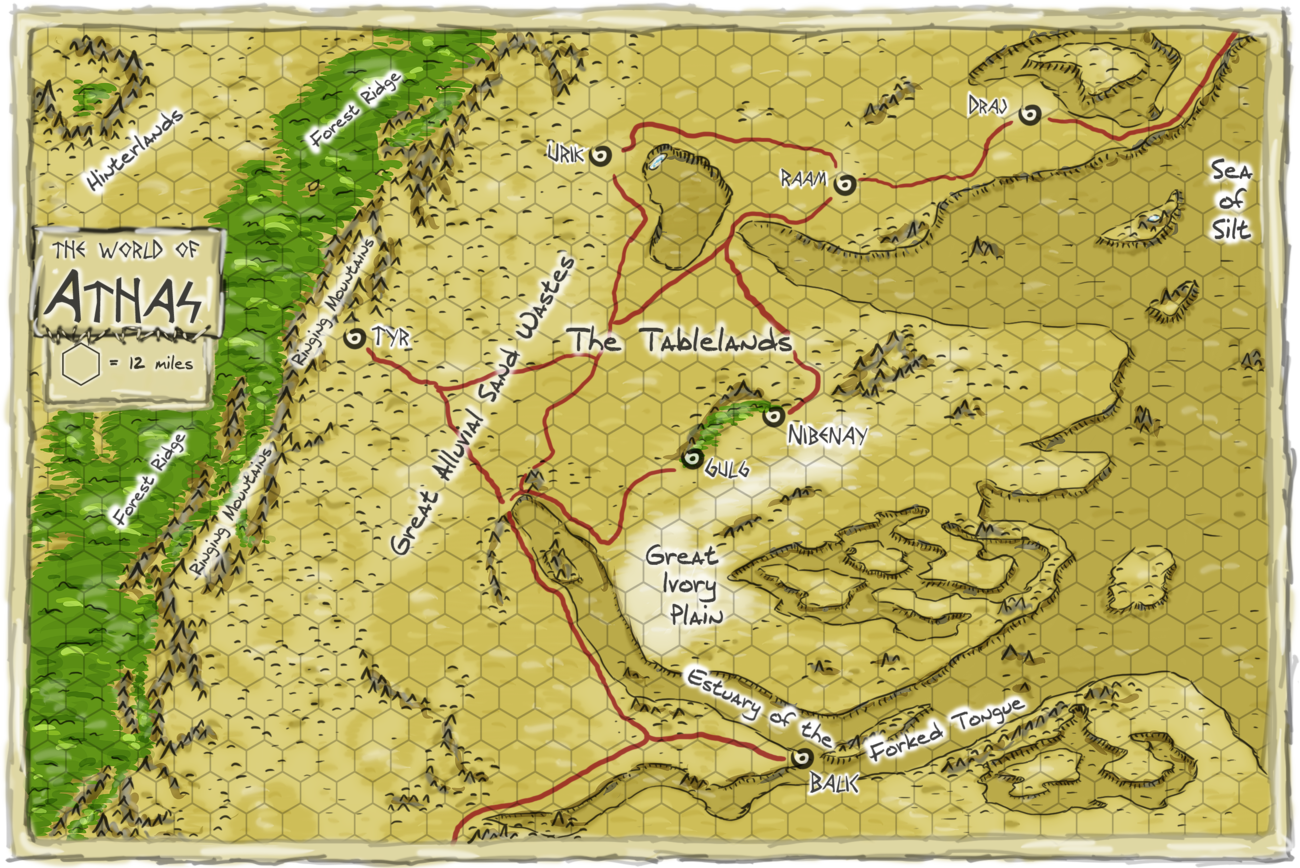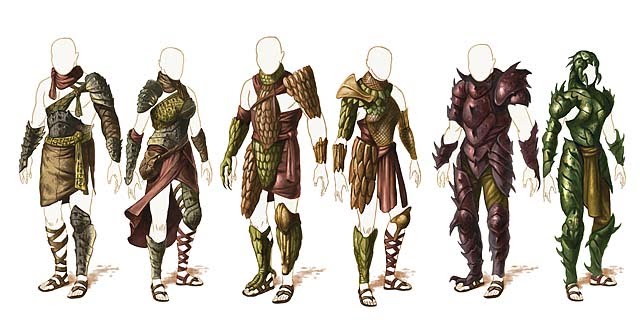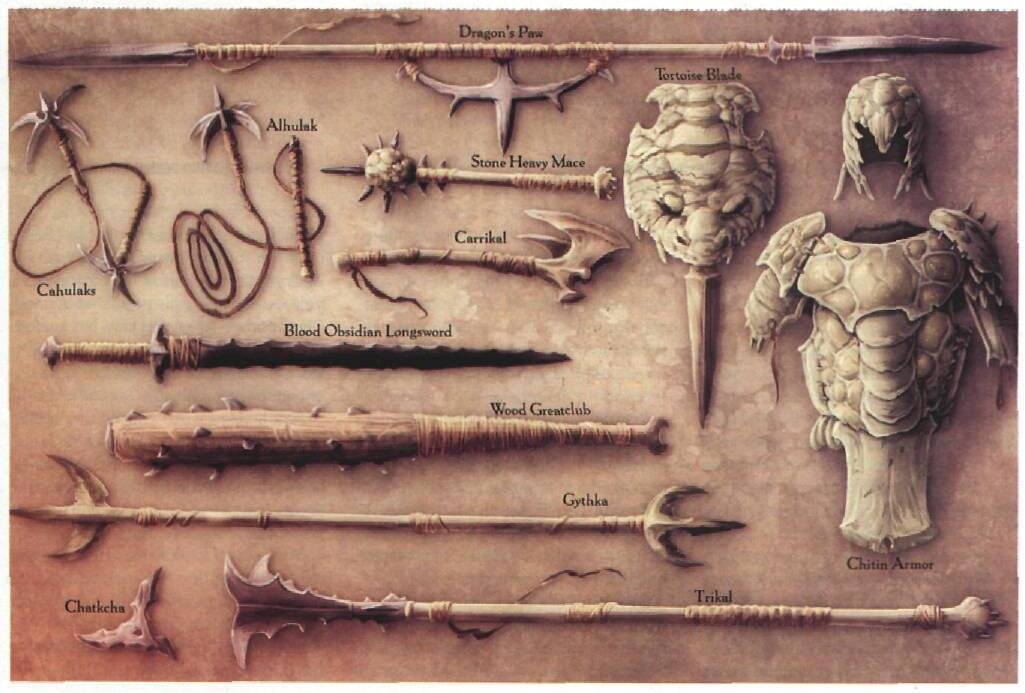The Savage Sun
Contents
The World
Setting Rules
The following setting rules are in use:
- BORN A HERO: Player characters ignore Rank requirements for Edges during character creation.
- FANATICS: Enemy thugs take the damage for their masters.
- FAST HEALING: Characters make natural healing rolls once per day instead of every five days, and recover a level of Fatigue from Bumps & Bruises every four hours instead of every day.
- HIGH ADVENTURE: Spend a Benny to gain the one-time use of a Combat Edge.
- UNARMORED HERO: Wild Cards without armor add +2 to their Soak rolls.
- WOUND CAP: Wild Cards never suffer more than four wounds from a single hit
The People
Humans
- Adaptable. Humans start with a free bonus edge. They must qualify for the edge normally.
- Broadly Skilled. Humans start with d4 each in two skills, or d6 in one skill of their choice.
Aarakocra
- Agile. Aaracokra have a starting Agility of d6 and a maximum Agility of d12+1.
- Wings. Aarakocra have wings and can fly. They have a flying Pace of 12", but cannot fly if they are Bound or Entangled.
- Claustrophobia. Aarakocra are uncomfortable in enclosed spaces, and have claustrophobia as a minor hindrance.
- Hollow Bones. Their lightweight build and relatively fragile bones reduces an aarakocra's Toughness by 1.
Elves
- Agile. Elves have a starting Agility of d6 and a maximum Agility of d12+1.
- Born Thief. Elves have a natural inclination toward trickery, and start with d4 in Thievery.
- Swift. Elves have a Pace of 8" and a running die of d8.
- Bad Reputation. Elves have a reputation as untrustworthy thieves, and take a -2 penalty to Persuasion rolls among non-elves.
Dwarves
- Focus. [1] All dwarves have a Focus, a specific goal toward which they work. A dwarf gains a +1 bonus on all skill rolls made directly in pursuit of their focus.
- Hardy. [2] A dwarf who becomes Shaken from damage while already Shaken does not take a wound.
- Tough. [2] Dwarves have a starting Vigor of d6 and a maximum Vigor of 12+1.
- Driven [-1]. A dwarf is driven to complete their focus at all times, and can only turn away from it with an effort of will. All dwarves have Driven as a minor hindrance (a dwarf can upgrade this to Major as normal).
- Slow. [-1] Dwarves have a Pace of 5" and a running die of d4.
Dwarves are short, tough people, averaging four feet tall and almost twice as broad as a human of comparable height.
A Dwarf's Focus: All dwarves have a focus, a specific goal toward which they direct most of their energies.
Halflings
- Wise. Halflings have a starting Spirit of d6 and a maximum Spirit of d12+1
- Magic Resistance. All halflings possess the edge Arcane Resistance. They can take Improved Arcane Resistance normally.
- Resistant. Halflings gain a +2 bonus on Vigor rolls made to resist disease and poison.
- Small. Halflings average three to four feet tall, making them Size -1. This reduces their Toughness by 1.
Half-Elves
- Animal Ken. Half-elves gain a +2 bonus on any rolls made to peacefully interact with an animal. A half-elf can ignore the Spirit prerequisite when taking the Beast Master edge.
- Dual Heritage. A half-elf may start with a Dexterity of d6 and a maximum Dexterity of d12+1, or any edge the half-elf qualifies for as a bonus edge.
- Quick Learner. Half-elves start with d4 in any one skill of their choice, or d6 in any core skill.
Beast Friend:
Half-Giants
- Hardy. [2] A half-giant who becomes Shaken from damage while already Shaken does not take a wound.
- Large. [-] Half-giants stand ten feet tall and are heavily muscled. They are Size +2. This increases their Toughness by 2 and their maximum Strength by two ranks, but they take a -2 penalty on Trait rolls when using equipment designed for smaller races, and consume double the amount of food and drink as the smaller folk.
- Strong. [2] Half-giants have a starting Strength of d6 and a maximum Strength of d12+1. Their great size increases this to d10 and d12+3, respectively.
- Easily Led. [-1] Half-giants are highly susceptible to persuasion, and take a -2 penalty when resisting magical or psionic effects meant to control their behavior, as well as Smarts- and Spirit-based Tests.
- Poor Defenses. [-1] Because they are such large targets, half-giants take a -1 penalty to their Parry.
Muls (Half-Dwarves)
- Strong. [2] Muls have a starting Strength of d6 and a maximum Strength of d12+1.
- Tough. [2] Muls have a starting Vigor of d6 and a maximum Vigor of d12+1.
- Tireless. [2] Muls require only four hours of sleep each night, and gain a +2 bonus on Vigor rolls made to resist fatigue.
Thri-Kreen (Mantis Warriors)
- Claws. [2] Thri-kreen possess sharp claws which do Str + 1d4 damage.
- Leaper. [1] Thri-kreen can jump twice as far as normal for creatures of their Pace, and add +4 to their attack roll instead of +2 when they jump as part of a Wild Attack.
- Natural Armor. [1] A thri-kreen's exoskeleton gives it 2 points of armor.
- Sleepless. [2] Thri-kreen never sleep, although they can be rendered unconscious normally.
- Outsider. [-1] Thri-kreen are the most alien of the sapient races and take a -2 penalty on all Persuasion rolls among non-kreen.
Character Creation
New Edges
Elemental Adept
- Prerequisite: Arcane Background: Elemental Priest
Gladiator Display
- Prerequisite: Seasoned, Fighting d8, Intimidation or Taunt d6
You're a born showman in the arena. When you hit an enemy with a raise and deal enough damage to kill them, you gain a benny which must be used before the end of the encounter.
Subtle Spellcasting
- Prerequisite: Arcane Background: Magic
You know how to cast spells with the most minimal of words and gestures. Whenever you cast a spell, anyone nearby must succeed on a Notice roll at -2 to realize what you did. They may still realize that you caused some sort of supernatural effect, but they'll attribute it to psionics or clerical spellcasting.
Magic and Psionics
Defiling and Preserving
Psionics
Wild Talents
The vast majority of people on Athas possess a wild talent: an innate psionic ability gained without training or study. Wild talents require no training or study; the manifest instinctively, usually around puberty. Many wild talents are weak and borderline useless, such as the ability to project a tiny telekinetic force weaker than a shove.
Wild talents operate identically to normal powers, but a wild talent user has no relevant skill or power points. Rather, to activate a wild talent the character must spend a benny and roll their Spirit.
Wild talents cannot benefit from any power modifiers, whether general or specific to that power. The power manifested is always the basic version of the power.
All wild cards roll on the Wild Talents table to determine their talent. PCs may roll twice and take the power they prefer. Characters with the Arcane Background: Psionics edge do not develop wild talents in the usual way; they may roll normally but simply add their wild talent power to their list of psionic powers and use it normally.
| d20 roll | Power | Notes |
|---|---|---|
| 1 | Beast friend | |
| 2 | Blind | |
| 3 | Bolt | |
| 4 | Boost/Lower Trait | The character must choose whether they are able to boost or lower traits. A wild talent cannot do both. |
| 5 | Confusion | |
| 7 | Darksight | |
| 8 | Deflection | |
| 9 | Detect/Conceal Arcana | |
| 10 | Elemental Manipulation | |
| 11 | Empathy | |
| 12 | Entangle | |
| 13 | Environmental Protection | |
| 14 | Fear | |
| 15 | Havoc | |
| 16 | Healing | |
| 17 | Illusion | |
| 18 | Light/Darkness | |
| 19 | Mind Link | |
| 20 | Mind Reading | |
| 21 | Protection | |
| 22 | Relief | |
| 23 | Smite | |
| 24 | Sound/Silence | |
| 25 | Speak Language | |
| 26 | Stun | |
| 27 | Wall-Walker |
Gear and Equipment
Bone
Obsidian
Stone
Wood
| Type | Armor | Min Str | Weight | Cost | Covers |
|---|---|---|---|---|---|
| Heavy Cloth/Leather | |||||
| Jacket | +1 | d4 | 5 | 20 | torso, arms |
| Robes | +1 | d4 | 8 | 30 | torso, arms, legs |
| Leggings | +1 | d4 | 5 | 20 | legs |
| Cap | +1 | d4 | 1 | 5 | head |
| Scale/Bone/Chitin | |||||
| Jacket | +2 | d6 | 8 | 80 | torso, arms |
| Leggings | +2 | d6 | 7 | 40 | legs |
| Cap | +2 | d6 | 1 | 20 | head |
| Metal (chain) | |||||
| Shirt | +3 | d8 | 25 | 3,000 | torso, arms |
| Leggings | +3 | d8 | 10 | 1,500 | legs |
| Coif or Helm | +3 | d8 | 4 | 250 | head |
| Metal (plate) | |||||
| Corselet | +4 | d10 | 30 | 5,000 | torso |
| Vambraces | +4 | d10 | 10 | 2,000 | arms |
| Greaves | +4 | d10 | 10 | 2,000 | legs |
| Great Helm | +4 | d10 | 4 | 1,000 | head |
| Type | Damage | Min St | Weight | Cost | Notes |
|---|---|---|---|---|---|
| Alhulak | Str + d4 | d4 | 2 | 100 | range 3/6/12 |
| Calhulaks | Str + d4 | d6 | 4 | 200 | Double weapon, two hands |
| Carrikal | Str + d8 | d8 | 6 | 400 | +1d10 damage on a raise |
| Chatkcha | Str + d6 | d6 | 3 | 150 | Range 6/12/24 |
| Dragon's Paw | Str + d8 | d8 | 8 | 300 | Double weapon, Parry +1, two hands |
| Gythka | Str + d6 | d6 | 4 | 150 | Double weapon, two hands |
| Tortoise Blade | Str + d6 | d8 | 6 | 150 | Parry +1 |
| Trikal | Str + d10 | d10 | 10 | 400 | Two hands, reach +1 |
- Alhulak: A four-pronged blade on a short handle, the alhulak has a length of rope or braided leather attached to the handle. A skilled wielder can use it to hook an enemy's legs and drag them closer or knock them prone. On a raise, in lieu of extra damage, the wielder of the alhulak can make an opposed Strength check to either drag the enemy 2" closer or cause them to fall prone.
- A pair of alhulaks joined by a short rope or length of leather, the calhulaks is a favorite arena weapon. It is functionally a set of matched knives, and the wielder cannot be disarmed of either unless he is disarmed of both in the same round. If the wielder makes two attacks in the same round with this weapon, the multi-action penalty is reduced to -1.
- Carrikal: Traditionally made from the sharpened jawbone of an animal, a carrikal resembles a double-bladed axe. Although heavy and somewhat awkward, it can inflict devastating wounds. A carrikal functions as a battleaxe, but on a raise it does +1d10 extra damage instead of +1d6.
- Chatkcha: This deadly crystalline throwing wedge is favored by the thri-kreen; it is roughly triangular in shape and sharpened to a razor's edge.
- Dragon's paw: An arena favorite, the dragon's paw is a short polearm with a heavy blade at either end and a bladed guard in the middle. If the wielder makes two attacks in the same round with this weapon, the multi-action penalty is reduced to -1.
- Gythka: A favorite melee weapon of the thri-kreen, a gythka resembles a short polearm with a blade on each end. If the wielder makes two attacks in the same round with this weapon, the multi-action penalty is reduced to -1.
- Tortoise blade: A blade attached to a round shield (traditionally made from a tortoise shell) that covers the wielder's forearm, this is effectively a short sword with a shield attached. It grants +1 to parry and functions as a normal shield, but if the wielder is disarmed they lose the shield as well.
- Trikal: A long, heavy club, the trikal has great reach and is a favored weapon of half-giants.
Athas
Metal Gear: On Athas, metal is extremely rare and valuable. Metal gear is as described in the core SWADE rules, but the cost is ten times higher: a metal longsword will cost at least $3,000 if it is available for purchase at all. As a result, most weapons are made from other materials, such as wood, bone, stone, chitin and obsidian. These weapons may be weaker and less effective than their metal counterparts.
In addition, non-metal weapons have a chance to shatter in combat.
The following weapons are not typically made with metal, and can be purchased at 50% of their listed price and used normally: Club (light or heavy), flail, lance, pike, spear/javelin, staff, bow, longbow, sling, net.
The table below summarizes the mechanical effects of weapons made of various non-metal materials.
| Material | Fighting | Damage | Weight | Cost | Notes |
|---|---|---|---|---|---|
| Bone/Chitin | - | -1 | 75% | 75% | |
| Obsidian | - | - | 100% | 100% | |
| Stone | -1 | -1 | 100% | 50% | |
| Wood | -2 | -2 | 50% | 25% |
Other Adventuring Gear



